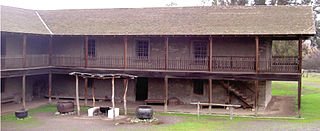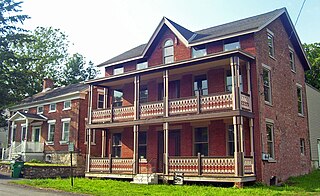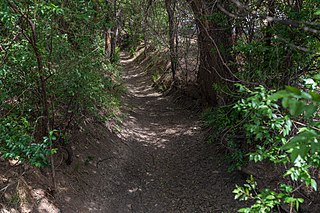
San Felipe de Neri Church is a historic Catholic church located on the north side of Old Town Plaza in Albuquerque, New Mexico. Built in 1793, it is one of the oldest surviving buildings in the city and the only building in Old Town proven to date to the Spanish colonial period. The church is listed on the New Mexico State Register of Cultural Properties and the National Register of Historic Places and has remained in continuous use for over 200 years.

The Gilbert Millspaugh House is located on Church Street in Walden, New York, United States. It is a 2005 addition to the National Register of Historic Places, built in a Victorian style for a local man named Richard Masten. Later it was home to Gilbert Millspaugh, son of a local furniture retailer.

The Juan de Anza House, also known as the Casa de Anza, is a historic adobe house in San Juan Bautista, California. Built around 1830, Casa de Anza is a well-preserved example of residential construction from the period of Mexican California. It was declared a National Historic Landmark in 1970.

The Nathan and Mary (Polly) Johnson properties are a National Historic Landmark at 17–19 and 21 Seventh Street in New Bedford, Massachusetts. Originally the building consisted of two structures, one dating to the 1820s and an 1857 house joined with the older one shortly after construction. They have since been restored and now house the New Bedford Historical Society. The two properties are significant for their association with leading members of the abolitionist movement in Massachusetts, and as the only surviving residence in New Bedford of Frederick Douglass. Nathan and Polly Johnson were free African-Americans who are known to have sheltered escaped slaves using the Underground Railroad from 1822 on. Both were also successful in local business; Nathan as a caterer and Polly as a confectioner.

Monterey Colonial is an architectural style developed in Alta California. Although usually categorized as a sub-style of Spanish Colonial style, the Monterey style is native to the post-colonial Mexican era of Alta California. Creators of the Monterey style were mostly recent immigrants from New England states of the US, who brought familiar vernacular building styles and methods with them to California.

The Main Street Historic District in New Hamburg, New York, United States is located along that street just west of the train station. Six buildings on a single acre are an intact remnant of the hamlet as it was developed in the middle of the 19th century, prior to the Hudson River Railroad's construction, which cut it in half.

The Methodist Episcopal Church of Winooski, also known as the Winooski United Methodist Church, is an historic Methodist church building located at 24 West Allen Street in Winooski, Vermont. It was built in 1918, and is a significant local example of vernacular Carpenter Gothic architecture. On March 2, 2001, it was added to the National Register of Historic Places.

The former Eighth Precinct Police Station is a building located at 4150 Grand River Avenue in the Woodbridge Historic District of Detroit, Michigan. It is the second-oldest police building in Detroit, and was designated a Michigan State Historic Site in 1973 and listed on the National Register of Historic Places in 1974. The building now houses the Detroit Castle Lofts.

Territorial Style was an architectural style of building developed and used in Santa Fe de Nuevo México, popularized after the founding of Albuquerque in 1706. Reintroduced during the New Mexico Territory from the time of the Mexican and American territorial phases in 1821 until 1912, at which time New Mexico stopped being a territory and became a US state. Following the increase of its popularity in the 1930s and 1940s, it became referred to as the Territorial Revival style, which became another popular building style alongside New Mexico's Pueblo Revival style.

The Arizona Rancho, also known as the Higgins House, Brunswick Hotel and Arizona Hotel, is a former hotel in Holbrook, Arizona. It was originally built between 1881 and 1883 as a residence, the expanded as a boarding house, a hotel, and finally as a motel. The original structure is thought to be the oldest extant structure in Holbrook.

Meriden Town Hall is a historic municipal building at 110 Main Street in the Meriden village of Plainfield, New Hampshire. The building, still serving its original function, is the only purpose-built town hall building in Plainfield, whose government is divided between Plainfield village and Meriden. The building was listed on the National Register of Historic Places in 1998.
The Manuelita Trujillo House, near Los Ojos, New Mexico, was listed on the National Register of Historic Places in 1985.
The Tom Eby Storage Building, near Dwyer, New Mexico, was built in 1888 or later. It was listed on the National Register of Historic Places in 1988.
The San Juan Historic District in San Juan, New Mexico is a 23 acres (9.3 ha) historic district which was listed on the National Register of Historic Places in 1988. The listing included 14 contributing buildings and two non-contributing buildings.

The Camino del Monte Sol Historic District, in Santa Fe, New Mexico, is a 52.1 acres (21.1 ha) historic district which was listed on the National Register of Historic Places in 1988. The listing included 106 contributing buildings.

The Acequia Madre, in Las Vegas, New Mexico, is a historic acequia which was built at the time of Las Vegas' settlement in 1835–36. It was listed on the National Register of Historic Places in 1987.

The House at 913 2nd, in Las Vegas, New Mexico, was built around 1885. It was listed on the National Register of Historic Places in 1985.
The Casados House, in Rio Arriba County, New Mexico near Los Ojos, New Mexico, was built in 1885. It was listed on the National Register of Historic Places in 1985.

The Delfina Gurule House is a historic house in Albuquerque, New Mexico. It was built by Delfina Gurule (1883–1979), who bought the lot in 1912 from Dolores Otero Burg, the daughter of former Congressional delegate Mariano S. Otero. The house was probably built shortly afterward, and Gurule lived there until her death in 1979. The building was added to the New Mexico State Register of Cultural Properties in 1979 and the National Register of Historic Places in 1980.

The Hilario Lopez House is a historic house in Albuquerque, New Mexico. It was built around 1907 by Hilario Lopez, who worked as a carpenter for the Atchison, Topeka and Santa Fe Railway. The house was added to the New Mexico State Register of Cultural Properties in 1979 and the National Register of Historic Places in 1980.
















